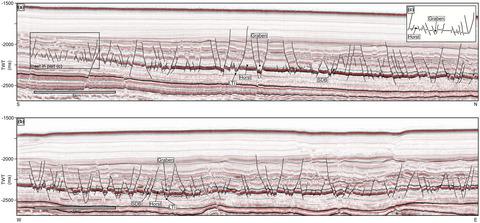当前位置:
X-MOL 学术
›
Basin Res.
›
论文详情
Our official English website, www.x-mol.net, welcomes your
feedback! (Note: you will need to create a separate account there.)
Systematic spacing and topological variations in layer-bound fault systems
Basin Research ( IF 2.8 ) Pub Date : 2021-07-09 , DOI: 10.1111/bre.12582 Mark T. Ireland 1 , Chris K. Morley 2 , Richard J. Davies 1
Basin Research ( IF 2.8 ) Pub Date : 2021-07-09 , DOI: 10.1111/bre.12582 Mark T. Ireland 1 , Chris K. Morley 2 , Richard J. Davies 1
Affiliation

|
Polygonal fault systems, sometimes termed layer-bound faults, are extraordinary features of many fine-grained sedimentary successions and have been described in a significant number of sedimentary basins over the last two decades. Their formation represents an important mechanism by which fine-grained sediments compact often resulting in a variety of complex patterns for which several controlling factors have been proposed. Here, three-dimensional seismic data from the North West Shelf of Australia are used to interpret previously undescribed characteristics of layer-bound fault systems where systematic horst and graben structures are the dominant structural style. Conjugate fault pairs, which form the horsts and grabens, frequently have a systematic spacing with graben-bounding faults exhibiting a spacing of half that of the horst-bounding faults. This systematic spacing of fault pairs indicates, (a) the presence of a mechanically weaker layer at the base of the fault system and (b) that the horizontal shortening required by the volume loss due to compaction can be accommodated without reaching saturation with respect to fault intensity. Furthermore, topological analysis indicates that areas with different patterns also have different intersection and branch characteristics, and these differences suggest that the growth of layer-bound faults is not explained by a single model. The findings have implications for the genesis and growth of layer-bound fault systems and the potential for cross-stratal fluid flow.
中文翻译:

层界断层系统中的系统间距和拓扑变化
多边形断层系统,有时也称为层状断层,是许多细粒沉积序列的非凡特征,在过去的 20 年里已在大量沉积盆地中得到描述。它们的形成代表了一种重要的机制,通过这种机制,细粒沉积物通常会导致各种复杂的模式,为此提出了几个控制因素。在这里,来自澳大利亚西北大陆架的三维地震数据用于解释以前未描述的层状断层系统的特征,其中系统地垒和地堑结构是主要的构造类型。形成地堑的共轭断层对通常具有系统的间距,地堑边界断层的间距是地堑边界断层的一半。这种断层对的系统间距表明,(a) 在断层系统底部存在一个机械强度较弱的层,以及 (b) 由于压实造成的体积损失所需的水平缩短可以得到满足,而不会达到饱和故障强度。此外,拓扑分析表明,不同模式的区域也具有不同的交叉和分支特征,这些差异表明层界断层的增长不是由单一模型解释的。这些发现对层状断层系统的形成和增长以及跨地层流体流动的潜力具有重要意义。(a) 断层系统底部存在机械强度较弱的层,以及 (b) 可以适应由于压实造成的体积损失所需的水平缩短,而不会在断层强度方面达到饱和。此外,拓扑分析表明,不同模式的区域也具有不同的交叉和分支特征,这些差异表明层界断层的增长不是由单一模型解释的。这些发现对层状断层系统的形成和增长以及跨地层流体流动的潜力具有重要意义。(a) 断层系统底部存在机械强度较弱的层,以及 (b) 可以适应由于压实造成的体积损失所需的水平缩短,而不会在断层强度方面达到饱和。此外,拓扑分析表明,不同模式的区域也具有不同的交叉和分支特征,这些差异表明层界断层的增长不是由单一模型解释的。这些发现对层状断层系统的形成和增长以及跨地层流体流动的潜力具有重要意义。拓扑分析表明,不同模式的区域也具有不同的交叉和分支特征,这些差异表明层界断层的增长不是由单一模型解释的。这些发现对层状断层系统的形成和增长以及跨地层流体流动的潜力具有重要意义。拓扑分析表明,不同模式的区域也具有不同的交叉和分支特征,这些差异表明层界断层的增长不是由单一模型解释的。这些发现对层状断层系统的形成和增长以及跨地层流体流动的潜力具有重要意义。
更新日期:2021-09-03
中文翻译:

层界断层系统中的系统间距和拓扑变化
多边形断层系统,有时也称为层状断层,是许多细粒沉积序列的非凡特征,在过去的 20 年里已在大量沉积盆地中得到描述。它们的形成代表了一种重要的机制,通过这种机制,细粒沉积物通常会导致各种复杂的模式,为此提出了几个控制因素。在这里,来自澳大利亚西北大陆架的三维地震数据用于解释以前未描述的层状断层系统的特征,其中系统地垒和地堑结构是主要的构造类型。形成地堑的共轭断层对通常具有系统的间距,地堑边界断层的间距是地堑边界断层的一半。这种断层对的系统间距表明,(a) 在断层系统底部存在一个机械强度较弱的层,以及 (b) 由于压实造成的体积损失所需的水平缩短可以得到满足,而不会达到饱和故障强度。此外,拓扑分析表明,不同模式的区域也具有不同的交叉和分支特征,这些差异表明层界断层的增长不是由单一模型解释的。这些发现对层状断层系统的形成和增长以及跨地层流体流动的潜力具有重要意义。(a) 断层系统底部存在机械强度较弱的层,以及 (b) 可以适应由于压实造成的体积损失所需的水平缩短,而不会在断层强度方面达到饱和。此外,拓扑分析表明,不同模式的区域也具有不同的交叉和分支特征,这些差异表明层界断层的增长不是由单一模型解释的。这些发现对层状断层系统的形成和增长以及跨地层流体流动的潜力具有重要意义。(a) 断层系统底部存在机械强度较弱的层,以及 (b) 可以适应由于压实造成的体积损失所需的水平缩短,而不会在断层强度方面达到饱和。此外,拓扑分析表明,不同模式的区域也具有不同的交叉和分支特征,这些差异表明层界断层的增长不是由单一模型解释的。这些发现对层状断层系统的形成和增长以及跨地层流体流动的潜力具有重要意义。拓扑分析表明,不同模式的区域也具有不同的交叉和分支特征,这些差异表明层界断层的增长不是由单一模型解释的。这些发现对层状断层系统的形成和增长以及跨地层流体流动的潜力具有重要意义。拓扑分析表明,不同模式的区域也具有不同的交叉和分支特征,这些差异表明层界断层的增长不是由单一模型解释的。这些发现对层状断层系统的形成和增长以及跨地层流体流动的潜力具有重要意义。











































 京公网安备 11010802027423号
京公网安备 11010802027423号